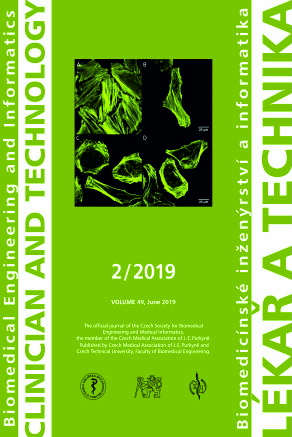ANALYSIS OF NEURAL ACTIVITY OF THE HUMAN BASAL GANGLIA IN DYSTONIA: A REVIEW
DOI:
https://doi.org/10.14311/CTJ.2019.2.05Keywords:
electrophysiology, microrecording, spike sorting, biomarkers, neuromodulation, dystoniaAbstract
Deep brain stimulation of the globus pallidus internus is an efective symptomatic treatment for pharmacoresistant dystonic syndromes, where pathophysiological mechanisms of action are not yet fully understood. The aim of this review article is to provide an overview of the state-of-the-art approaches for processing of microelectrode recordings in dystonia; in order to define biomarkers to identify patients who will benefit from the clinical deep brain stimulation. For this purpose, the essential elements of microelectrode processing are examined. Next, we investigate a real example of spike sorting processing in this field. Herein, we describe baseline elements of microrecordings processing including data collection, preprocessing phase, features computation, spike detection and sorting and finally, advanced spike train data analysis. This study will help readers acquire the necessary information about these elements and their associated techniques. Thus, this study is supposed to assist during identification and proposal of interesting clinical hypotheses in the field of single unit neuronal recordings in dystonia.Downloads
Published
Issue
Section
License
Authors who publish with this journal agree to the following terms:
- Authors retain copyright and grant the journal right of the first publication with the work simultaneously licensed under a Creative Commons Attribution License (https://creativecommons.org/licenses/by/4.0/) that allows others to share the work with an acknowledgment of the work's authorship and initial publication in CTJ.
- Authors are able to enter into separate, additional contractual arrangements for the non-exclusive distribution of the journal’s published version of the work (e.g., post it to an institutional repository or publish it in a book), with an acknowledgment of its initial publication in this journal.
- Authors are permitted and encouraged to post their work online (e.g., in institutional repositories or on their website or ResearchGate) prior to and during the submission process, as it can lead to productive exchanges.
CTJ requires that all of the content of the manuscript has been created by its respective authors or that permission to use a copyrighted material has been obtained by the authors before submitting the manuscript to CTJ. CTJ requires that authors have not used any copyrighted material illegally, as for example a picture from another journal or book, a photo, etc. It is the author’s responsibility to use only materials not violating the copyright law. When in doubt, CTJ may ask the authors to supply the pertinent permission or agreement about the use of a copyrighted material.
The opinions expressed in CTJ articles are those of authors and do not necessarily reflect the views of the publishers or the Czech Society for Biomedical Engineering and Medical Informatics.


